
We’re here to help! Wild Yards is a completely free website that is 100% dedicated to helping you create a wildlife-friendly, sustainable yard. Read more
WildYards is reader-supported. When you buy a product through a link on our site, we may earn a comission. Every product is independently selected by our (obsessive) editors and our reviews are unbiased and objective. Read more about our mission or our privacy policy.
Would it surprise you to learn that most of the fruits and vegetables that you enjoy on a daily basis were actually man-made? It’s true! Broccoli, cauliflower, bananas, apples, and corn are some of the most popular produce at the grocery store, and they’re all the result of years of selective cultivation courtesy of mankind. Since so many fruits and vegetables were hybridized by humans, that begs the question: are carrots man-made, too?
Yes, the carrots that we purchase from supermarkets today are man-made — the result of centuries of careful hybridization. While all carrots are descended from Daucus carota, Carota, a wild carrot found in modern-day Iran and Afghanistan, today’s carrots have largely been shaped by humans, rather than mother nature.
Are carrots completely man-made?
This is where the answer to the title question gets a bit more complicated. Are carrots man-made? Yes, but are they completely man-made? No. Carrots weren’t created in a lab or artificially manufactured in any way. The modern carrots we know today were actually first cultivated from wild carrots (Daucus carota, Carota) found in nature centuries ago.
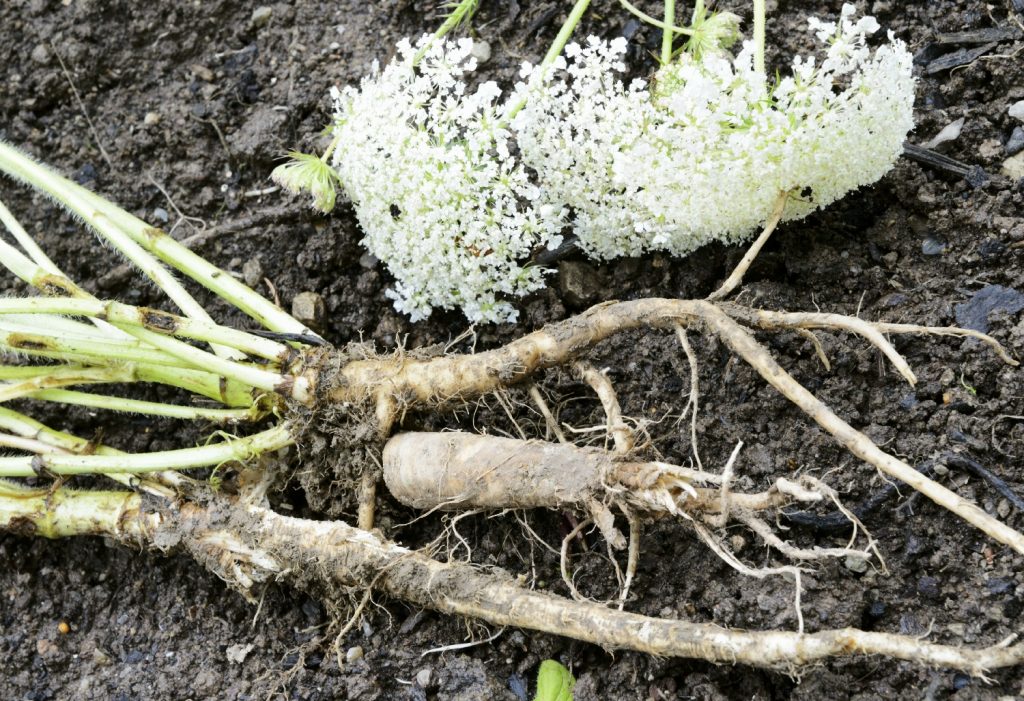
Carrots have quite a colorful history. As it happens, carrots were originally grown for their aromatic tops and seeds rather than their roots, which were very bitter. The medicinal properties of the plant’s foliage were recognized long before its root’s culinary uses. Carrot greens are highly nutritious, providing consumers with ample doses of iron, calcium, and vitamins A and C. Eventually, carrot roots were found to be of value, too, and they were cultivated to be sweeter, crisper, and more palatable than their predecessors.
Modern carrots (Daucus carota, sativus) developed from wild carrots found in Iran and Afghanistan more than 5,000 years ago. These early carrots were probably white or purple in color before the 14th century, when they were introduced to Europe and red and yellow varieties sprang up. While the world was slow to warm up to the wild carrot’s bitterness, it quickly took a liking to the sweeter taste of later cultivars. Today, carrots are the 6th most consumed vegetable in the United States, with California producing 85% of the carrots purchased on American soil.
When did carrots develop into the orange carrots we know today?
For centuries, carrots were much smaller and much less sweet than they are today. They also came in a variety of colors, and while you can still purchase rainbow carrot seeds to grow in your garden, these vibrant carrots were much more common than they are nowadays.
It wasn’t until carrots arrived in Europe that they started to take on the orange hue we’ve come to expect from modern carrots. Legend has it that orange carrots were developed by the Dutch to honor William of Orange, but there isn’t much evidence to support this claim.
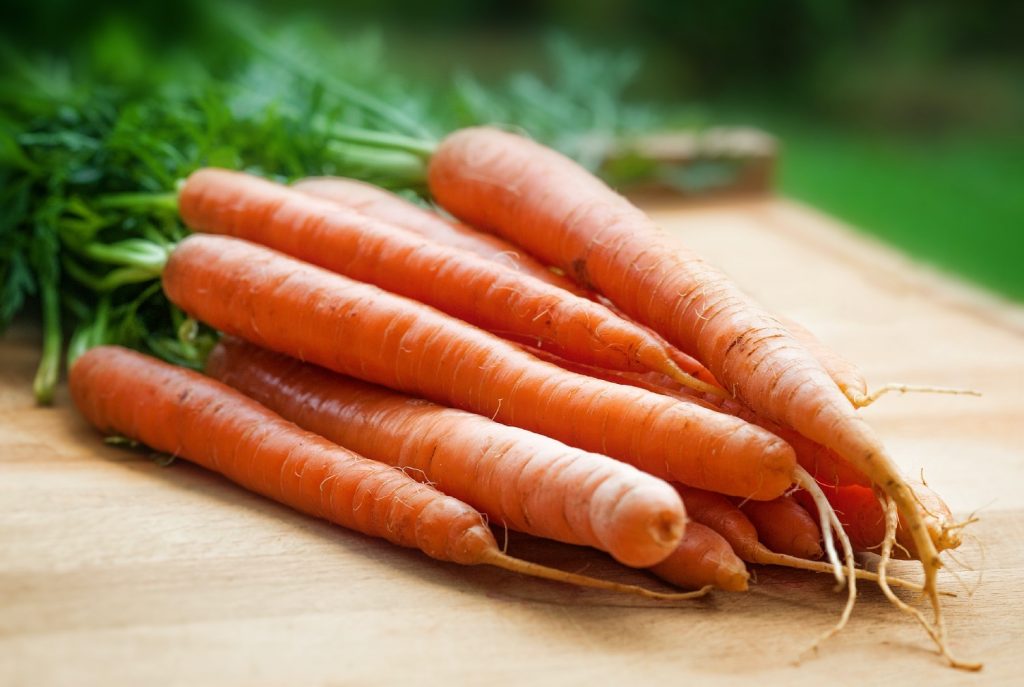
It’s believed that carrots with orange roots first appeared in Spain and Germany in the 1400s and 1500s. These carrots were preferred over other carrot colors because they didn’t stain cookware. Because most people couldn’t afford to replace their dishes every time they served carrots, stainless orange carrots quickly grew in popularity.
Over time, carrots were also cultivated to be bigger. Large carrots go further and require less prep-work in the kitchen than a bunch of smaller carrots. So carrots have been hybridized over the decades to retain their orange pigment and grow as large as possible — usually up to 12 inches long, although the longest carrot ever recorded was an astonishing 20 feet in length.
If carrots are man-made, does that mean they’re genetically modified organisms (GMOs)?
Yes, and no. All hybridized plants, whether they’re fruits, vegetables, or ornamental shrubs and flowers, are genetically modified organisms in the purest sense of the phrase. The genetic fabric of these plants has been modified to emphasize certain qualities that humans value — for ornamental plants, that means producing more flowers or foliage. For fruits and vegetables, that means producing high-yield crops that taste better.
Of course, when people refer to genetically modified organisms, they’re generally speaking about plants that have been modified in a lab. And, it’s true, scientists have altered many crops to improve their resistance to certain pests and diseases. These scientifically engineered mutations do not exist in nature, however, that doesn’t mean they’re unsafe for consumption. It just means they’re easier for farmers to grow.
While scientists have genetically modified many fruits and vegetables, including soybeans, corn, tomatoes, and strawberries, carrots have been cultivated through natural processes, like grafting and cross-pollination. Modern carrots have been carefully selected to enhance natural qualities, not injected with DNA-altering substances in a lab.
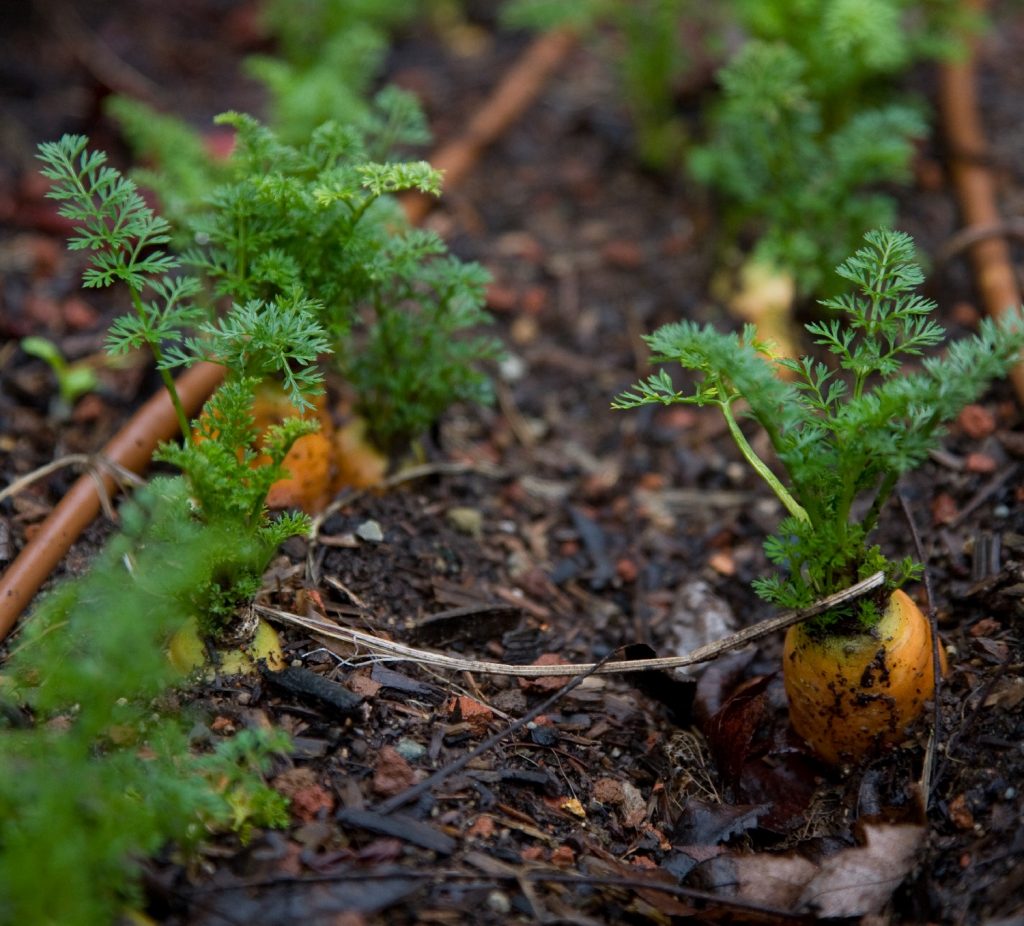
Are carrots safe to eat?
Yes, absolutely! Though they’ve been hybridized over the years, carrots have many health benefits to offer. For starters, these root veggies are full of beta carotene. It’s what gives them their classic carrot orange color, and it helps support cognitive function as well as skin and eye health.
The orange carrots we see at grocery stores support healthy digestion and detoxification, too. Making carrots a regular part of your diet is an easy way to improve your health. But orange carrots aren’t the only ones you can benefit from. Rainbow carrots are great for your health, too.
Purple carrots are rich in anthocyanins, which can help to reduce high blood pressure. Yellow carrots contain high levels of lutein, which is just as important for eye health as the orange carrot’s beta carotene. And red carrots have lots of lycopene, an antioxidant that fights free radicals and signs of aging.
White carrots have the least to offer. These carrots contain low levels of beta carotene, which is why they have no pigmentation. While these carrots are just as tasty as any other carrot, they’re not as nutritionally dense as their multicolored relatives.
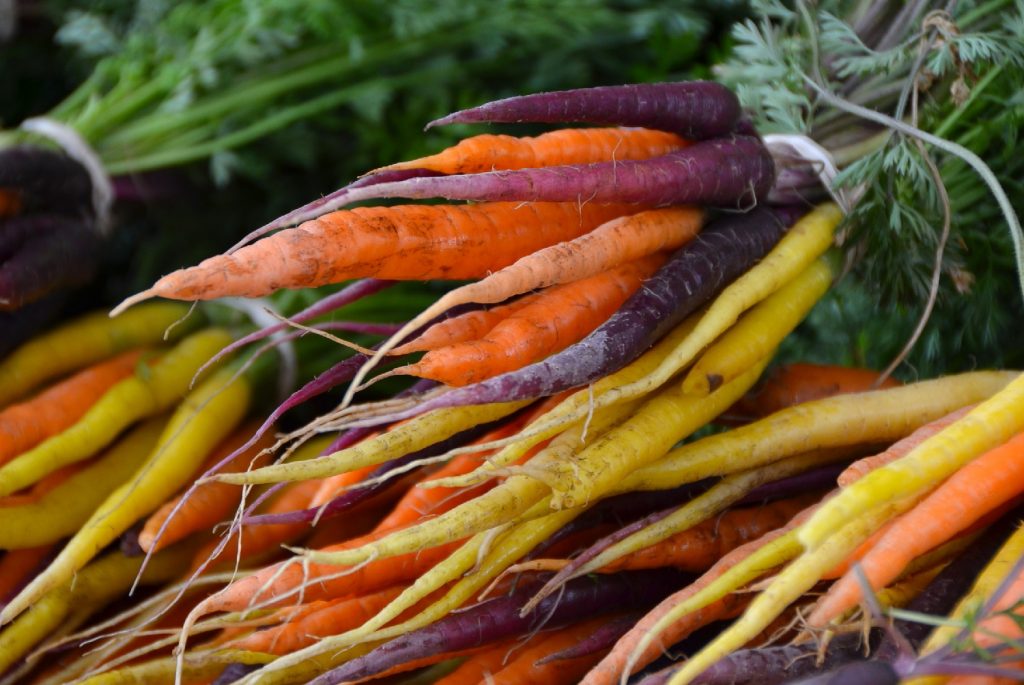
Are carrots easy to grow?
If you’re itching to grow your own carrots in your vegetable patch, we’ve got great news for you: they couldn’t be easier to grow. Carrots are great for beginner gardeners because they have a high germination rate. These are biennial plants that are typically harvested in their first year. Carrot leaves are delicate and lace-like and bear a great resemblance to fennel.
If you want to grow rainbow carrots in your garden, start by sowing the seeds in loose, sandy, well-drained soil that is slightly acidic. Seeds should be planted ¼-inch below the surface of the soil and should be kept 2 to 3 inches apart. Sow seeds in the spring 2 to 3 weeks before the last frost. Be sure to plant your carrots in a sunny location as they like lots of light.
Carrots should be watered regularly to keep the soil moist. But be careful not to overwater, as they may rot if the soil is soggy. Once the carrots sprout, you can thin them out a bit if you need to. Carrots are heavy feeders, and won’t grow well if they’re made to compete for space and nutrients.
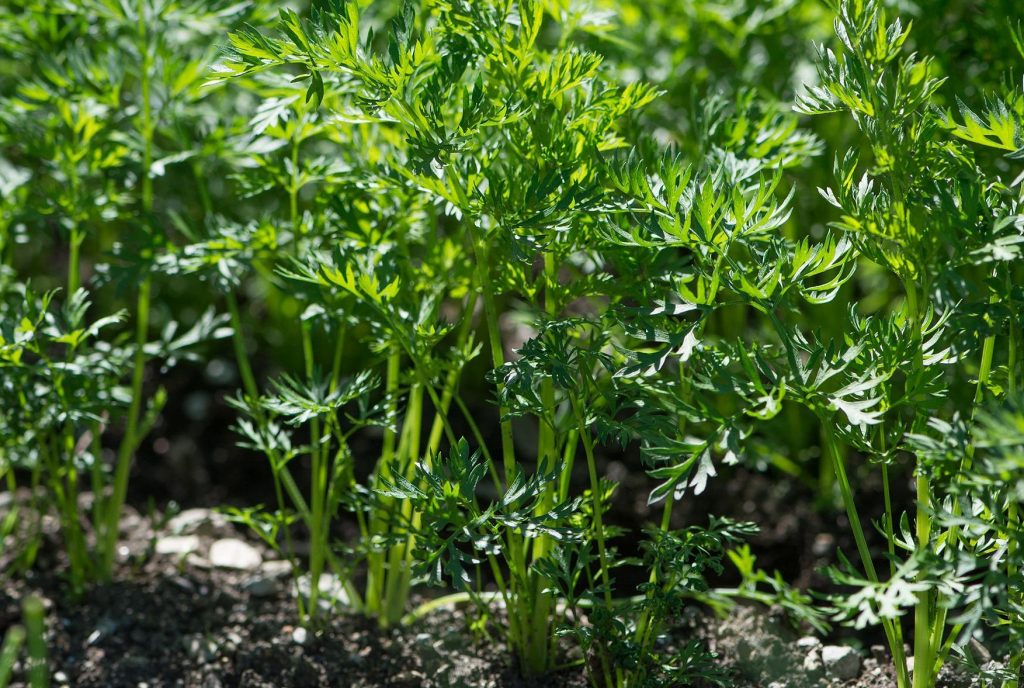
Can you grow carrots in pots?
You don’t have to have a ton of room to grow carrots. You can sow your carrot seeds in pots, window boxes, and small raised flower beds. Just be sure to drill a few holes in the bottom of the container before planting your carrots. Lining pots with a layer of gravel will help excess water escape so your carrots don’t rot before you can harvest them.
If you’re dealing with limited growing space, look for smaller carrot varieties. ‘Mini Adelaide’ and ‘Little Finger’ carrots grow around 4 inches long. These dwarf carrots are perfect for container gardens and make for a delicious snack.
When are carrots ready to be harvested?
Carrots are usually ready to be harvested 50 to 75 days after germination. If you dig around a bit at the base of the carrot tops, you should be able to feel the tip of the roots. This can help you gauge what size the carrots are. But, unfortunately, the only way to tell whether or not your carrots are ready is to pull one up and eat it.
To harvest your carrots, take a hand trowel and carefully dig around the carrot plant until the soil is loose enough to remove the root. Carrot roots are strong. They can cling to the ground around them and make removal difficult. Be careful not to jerk the tops off or stab the roots with your hand trowel as you wriggle them out of the soil.
Are homegrown carrots better than storebought?
If you’re leary of GMOs and you want to play on the safe side, it’s worth it to grow your own carrots at home. Sowing heirloom carrot seeds in your garden will allow you to grow some of the least-hybridized carrots available today. Homegrown carrots are often tastier, crunchier, and more nutritious than the mass-produced carrots available in grocery stores. Once you’ve tasted them fresh from your own garden, you’ll never go back to storebought.
While carrots are man-made in terms of hybridization, they weren’t genetically engineered in a lab. These are natural vegetables that have been cultivated by farmers over centuries to produce the delicious, nutritious carrots we know and love today. These root vegetables have a lot to offer, nutritionally speaking, and are safe for you and your family to enjoy on a regular basis.
